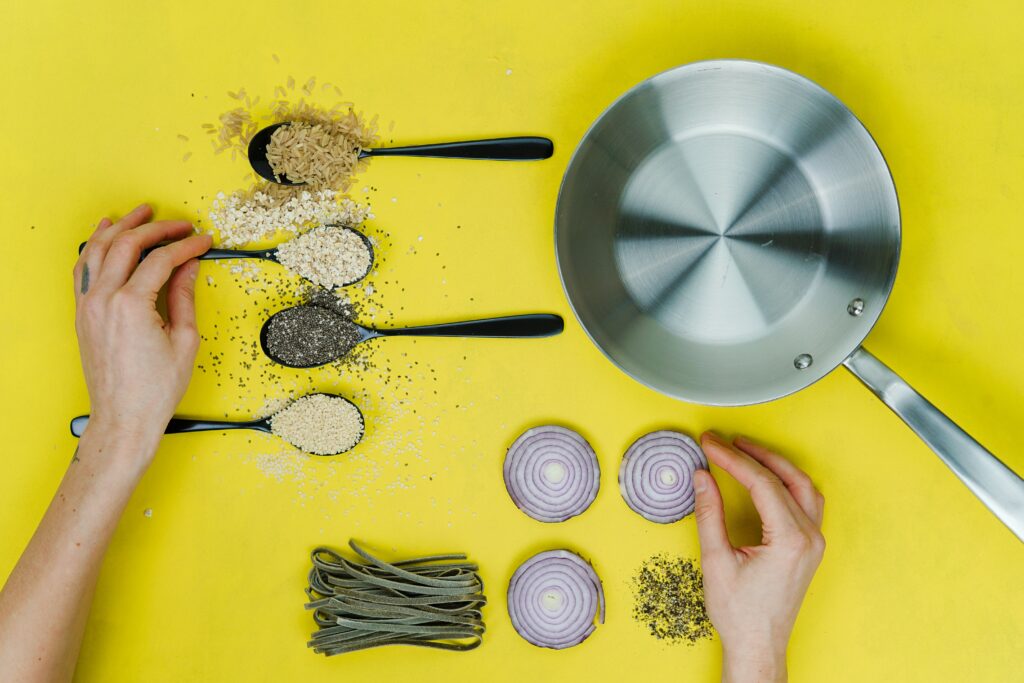This comprehensive article serves as a step-by-step guide, detailing the process of easily dicing an onion. Recognizing the ubiquitous role of onions as a staple ingredient in countless dishes, this guide emphasizes the importance of mastering the art of peeling and dicing an onion. Furthermore, it offers various techniques to prevent tears while cutting onions. Understanding that the yield of diced onion depends on the size of the onion itself, it underscores the significance of utilizing a sharp chef’s knife. This article provides readers with a clear set of instructions, encompassing the correct method of holding the onion, executing vertical and horizontal cuts, and discarding the root end. Additionally, it includes valuable tips, such as removing loose outer skin before starting and maintaining a secure grip on the knife and onion while slicing. Acknowledging the practicality of diced onions, the article also informs readers that they can be stored in the refrigerator for up to five days. Furthermore, it expands upon the topic, offering additional information on knife skills and a selection of the best chef’s knives of 2023.

Step 1: Gather Your Materials
To start the process of dicing an onion, you will need the following materials:
-
Sharp chef’s knife: Having a sharp knife is crucial for smoothly and safely dicing an onion. Dull knives can slip or require more pressure, increasing the risk of accidents. Invest in a high-quality chef’s knife with a sharp blade to make the task more efficient.
-
Cutting board: A stable and sturdy cutting board is essential for chopping vegetables, including onions. Choose a cutting board made of wood or plastic that is large enough to comfortably accommodate the size of the onion.
-
Onion: The star of the show, you will need at least one onion to practice your onion dicing skills. Choose an onion that is firm, with a dry papery skin and no visible signs of mold or soft spots.
Step 2: Prepare the Onion
Once you have gathered all your materials, it is time to prepare the onion for dicing. Follow these steps:
-
Remove the loose outer skin: Start by peeling the onion’s outermost layer, which is usually dry and papery. Simply use your hands to remove this layer and reveal the fresh onion underneath. Make sure to remove any loose skin to prevent it from interfering with the dicing process.
-
Trim off the root end: Once the loose outer skin has been peeled off, turn the onion on its side and trim off the root end. This step helps create a stable base for the onion, making it easier to handle and dice.

Step 3: Cut the Onion in Half
With the onion prepared, it is time to cut it in half. Follow these steps:
-
Place the onion on the cutting board: Position the onion vertically on the cutting board, with the flat, trimmed end facing downwards and the tapered end facing upwards. Ensure that the onion is stable and secure on the cutting board.
-
Cut the onion in half vertically: Using your sharp chef’s knife, make a vertical cut down the center of the onion, from the tapered end to the trimmed end. Apply steady even pressure to smoothly slice through the onion.
Step 4: Make Vertical Cuts
Now that the onion is halved, it is time to make vertical cuts. Follow these steps:
-
Hold one onion half with your non-dominant hand: To ensure stability and control, firmly grip one half of the onion with your non-dominant hand. Your fingertips should be curled inward to protect them from the knife.
-
Make vertical cuts into the onion, starting from the top: With a steady hand and a controlled grip on the onion, use your sharp chef’s knife to make vertical cuts vertically into the onion. Start from the top of the onion and work your way downwards, creating slices of desired thickness.
-
Leave about 1/2 inch from the bottom intact: As you slice through the onion, be mindful not to cut all the way through the bottom. Leave about 1/2 inch of the onion intact to hold the layers together during the dicing process.

Step 5: Make Horizontal Cuts
After making the vertical cuts, it is now time to make horizontal cuts. Follow these steps:
-
Hold the vertical onion half with your non-dominant hand: Continue to hold the onion securely with your non-dominant hand, ensuring that your fingertips are tucked away from the sharp edge of the knife.
-
Make horizontal cuts into the onion, starting from the top: Using your sharp chef’s knife, make horizontal cuts into the onion, starting from the top and working your way towards the bottom. These cuts should intersect with the vertical cuts you made earlier, resulting in a diced or minced onion.
-
Leave about 1/2 inch from the bottom intact: Similar to the vertical cuts, remember to leave a small portion at the bottom of the onion intact to maintain the onion’s structure during dicing.
Step 6: Dice the Onion
Now that the vertical and horizontal cuts have been made, it is time to dice the onion. Follow these steps:
-
Hold the diced onion with your non-dominant hand: After completing the vertical and horizontal cuts, hold the diced onion in place with your non-dominant hand. Use your fingers to gently secure the layers of the onion.
-
Gently separate the layers of onion: With your other hand, use your fingers or a fork to gently separate the layers of the diced onion. This will create individual pieces of diced onion that are ready to be used in your favorite recipes.
Step 7: Store the Diced Onion
If you do not plan to use all the diced onion immediately, it is important to store it properly to maintain freshness. Follow these steps:
-
Place the diced onion in an airtight container: Transfer the diced onion into a clean, airtight container. This will help prevent moisture and odors from seeping into the onion, keeping it fresh for longer.
-
Store in the refrigerator for up to five days: To maximize the shelf life of the diced onion, store it in the refrigerator. Diced onions can typically be stored for up to five days, allowing you to conveniently use them in various recipes throughout the week.
Tips for Easily Dicing an Onion
Dicing an onion can be a relatively simple and efficient process if you follow these helpful tips:
-
Remove loose outer skin before starting: Before you begin dicing the onion, take a moment to remove any loose or dry outer skin. This will make it easier to handle and cut the onion without any interference from the loose skin.
-
Securely hold the knife and onion while slicing: To ensure safety and precision, it is important to securely hold both the knife and the onion while slicing. Grip the knife firmly but comfortably, and hold the onion with a stable grip using your non-dominant hand. This will provide better control and minimize the risk of accidents.
Preventing Tears While Cutting Onions
Onions naturally release a chemical irritant called syn-propanethial-S-oxide, which can cause tearing and stinging of the eyes. Here are some techniques to help prevent tears while cutting onions:
-
Refrigerate the onion before cutting: Cold temperatures can help reduce the release of the eye-irritating compounds in onions. Consider placing the onion in the refrigerator for a short period before cutting to help minimize tear-inducing effects.
-
Cut near a running water source: Running water can help wash away the irritants released by the onion, reducing their impact on your eyes. Consider cutting the onion near a sink or with a steady stream of water nearby. Be cautious not to wet the onion excessively, as this can affect the texture and taste.
-
Chew gum while dicing the onion: Chewing gum can help distract your senses and reduce the chances of tearing up while cutting onions. The act of chewing gum produces saliva, which can help minimize eye irritation when cutting onions.
Recommendations for the Best Chef’s Knives of 2023
Having a reliable and high-quality chef’s knife is essential for any kitchen, including when dicing onions. Here are some top-rated chef’s knives to consider in 2023:
-
[Knife Brand A]: Known for its exceptional quality and durability, Knife Brand A offers a range of chef’s knives suitable for various culinary tasks. Their knives are made from high-quality stainless steel and feature ergonomic handles for comfortable and precise cutting.
-
[Knife Brand B]: With a reputation for excellence, Knife Brand B offers a selection of chef’s knives that are favored by both professional chefs and home cooks. Their knives are crafted with precision and attention to detail, providing excellent sharpness and balance.
-
[Knife Brand C]: If you are looking for a chef’s knife with a touch of elegance, Knife Brand C offers a range of beautifully designed knives that combine aesthetics with practicality. Made from high-quality materials, their knives provide superior cutting performance and ergonomic handles for comfortable use.
When choosing a chef’s knife, consider the following features:
-
Blade material: Opt for a chef’s knife with a blade made from high-quality stainless steel or carbon steel. These materials offer excellent sharpness, durability, and resistance to corrosion.
-
Blade size and shape: The size and shape of the blade should suit your cutting needs and personal preferences. A blade length of 8 to 10 inches is generally recommended for versatility.
-
Handle design: Look for a chef’s knife with an ergonomic handle that provides a comfortable grip and reduces strain during prolonged use. Consider the material and design of the handle to ensure it suits your hand size and preferences.
-
Weight and balance: The weight and balance of a chef’s knife are important factors to consider. A well-balanced knife will feel comfortable and stable in your hand, allowing for precise control while dicing onions and other ingredients.
In conclusion, dicing an onion doesn’t have to be a daunting task. By following these step-by-step instructions and utilizing helpful tips, you can easily and efficiently dice an onion for use in your favorite recipes. Remember to use a sharp chef’s knife, take precautions to prevent tears, and store the diced onion properly for optimal freshness. Consider investing in a quality chef’s knife to enhance your onion dicing skills and overall culinary experience. With practice and the right tools, you’ll be dicing onions like a pro in no time.
